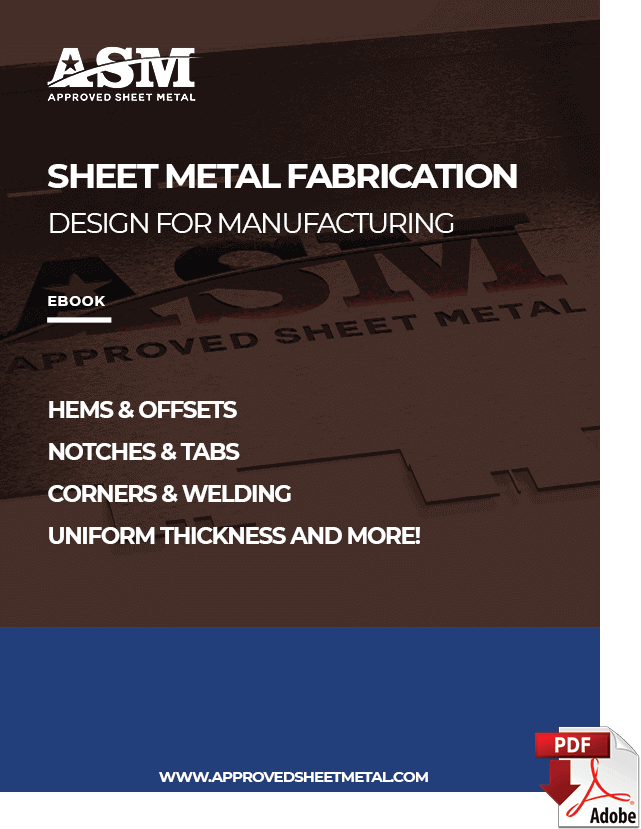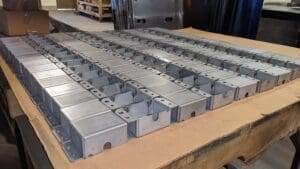Last updated on March 10th, 2025 at 09:54 am
Are you designing a sheet metal part that requires a hinge? 
A hinge is a type of hardware used in custom sheet metal fabrication that joins two parts together and facilitates rotation between them. Often used in doors, cabinets, boxes, and trays, hinges come in a variety of different options.
At Approved Sheet Metal, our customers often have questions about the best hinge for their parts. A hinge must be able to withstand the weight and usage of a part without breaking, so it’s important to make this selection wisely.
As a trusted sheet metal fabricator, we’re always happy to help you select the appropriate hinge for your needs.
Table of Contents
- 1 Common Hinge Types Used in Custom Sheet Metal Fabrication
- 2 Lift-off hinges
- 3 Key Factors to Consider When Selecting a Hinge
- 4 Durability and Wear Considerations for Sheet Metal Hinges
- 5 Approved Sheet Metal Can Help You Choose the Right Hinge
- 6 Sheet Metal Design for Manufacturing
- 7 Optimal Sheet Metal Hinge FAQ
- 7.0.1 What role does a hinge play in sheet metal fabrication, and why is selecting the right one important?
- 7.0.2 What are the common types of hinges used in custom sheet metal fabrication?
- 7.0.3 What factors should be considered when selecting a hinge for a sheet metal part?
- 7.0.4 How does Approved Sheet Metal assist in selecting the right hinge for a project?
- 7.0.5 Can you provide an example of hinge selection impacting a project's design?
Common Hinge Types Used in Custom Sheet Metal Fabrication
Here are the four hinge types we encounter the most often at our custom sheet metal fabrication shop:
Integrated/barrel hinges
Often used for box assemblies and other permanent constructions, integrated/barrel hinges are formed onto the part itself. We can attach integrated hinges using a punch press or press brake, but specialty tooling is required, making this hinge type a particularly expensive option.
Piano hinges
Piano hinges are often used on doors, lids and covers, and swing-out trays. Held together with a central pin, piano hinges are longer than other hinge types and have a wide range of motion. These hinges are typically spot welded onto the outside of a part.
Concealed hinges
When you don’t want a hinge to be visible from the outside, concealed hinges are the best choice. These small, bullet-shaped hinges have tabs that can be inconspicuously tack welded onto a part. This hinge type is also popular because it allows for slight adjustments after installation.
Lift-off hinges
Lift-off hinges are ideal in situations where you may need to remove one part of an assembly for servicing or cleaning (e.g., removing a door from an enclosure). Like piano hinges, lift-off hinges are held together with a pin, but the two parts can be detached by lifting one half and sliding it off.
Key Factors to Consider When Selecting a Hinge
Let’s examine the top factors to take into account when selecting a hinge for your custom sheet metal fabrication project.
Part weight and function
Consider how much your final assembly will weigh. Your hinge manufacturer or sheet metal fabricator can provide you with information regarding the load sizes that various hinge types can support.
Frequency of use
Each hinge type is further divided into standard and heavy-duty varieties. Manufacturer information will include details on which type you need for low-, medium-, or high-frequency parts of different weights.
Ideal number of hinges
If your design requires a piano hinge, for instance, you’ll likely need only one—even for a heavy part. But what if your application requires the easy removal of a cover? We recently worked on a project just like this one.
For this customer, we recommended using multiple lift-off hinges, which together can bear the same weight as a piano hinge but also facilitate simple part removal. We then worked with the customer to modify the part cover to accommodate this hinge configuration.
Durability and Wear Considerations for Sheet Metal Hinges
Selecting the right hinge for a sheet metal assembly goes beyond just function—it must also withstand repeated use, environmental conditions, and potential wear over time. Here are key factors to consider for ensuring long-lasting hinge performance:
1. Load-Bearing Capacity and Fatigue Resistance
Hinges experience repetitive motion and loading cycles, making material selection and design crucial for long-term durability. High-cycle applications, such as doors and enclosures that are opened and closed frequently, require hinges rated for fatigue resistance.
- Heavy-duty hinges with reinforced knuckles or additional bearings help distribute forces more evenly.
- Finite Element Analysis (FEA) can be used to predict stress distribution and fatigue failure points in a hinge design.
2. Friction, Lubrication, and Corrosion Protection
Friction between hinge components can lead to premature wear. Proper lubrication and surface treatments can extend hinge lifespan:
- Self-lubricating hinges (e.g., polymer bushings or oil-embedded bronze) reduce maintenance needs.
- Anti-corrosion coatings like zinc plating, anodizing (for aluminum), or stainless steel construction help prevent rust in harsh environments.
3. Environmental and Temperature Resistance
If your hinge will be exposed to moisture, chemicals, or extreme temperatures, consider:
- Sealed or gasketed hinges for moisture and dust protection.
- Stainless steel or polymer hinges for applications requiring high corrosion resistance (e.g., marine or medical settings).
- High-temperature alloys like Inconel or heat-treated steel for applications involving heat exposure.
4. Impact and Shock Resistance
In environments where the hinge may experience sudden forces (e.g., industrial enclosures or equipment doors), opt for:
- Spring-loaded or damped hinges to absorb shock and control movement.
- Thicker gauge materials or reinforced mounting points to prevent deformation under impact.
Approved Sheet Metal Can Help You Choose the Right Hinge
Your sheet metal fabricator should be able to recommend the best hinge type for your project by carefully considering your part’s application, weight, and expected frequency of use.
At ASM, our team members are highly knowledgeable about all hinge types and are pleased to work with hinges you supply or recommend the optimal hinges to order. We are always committed to helping our customers get the highest-quality sheet metal parts and assemblies for their money.
Request a quote for our custom sheet metal fabrication services!





